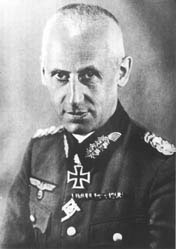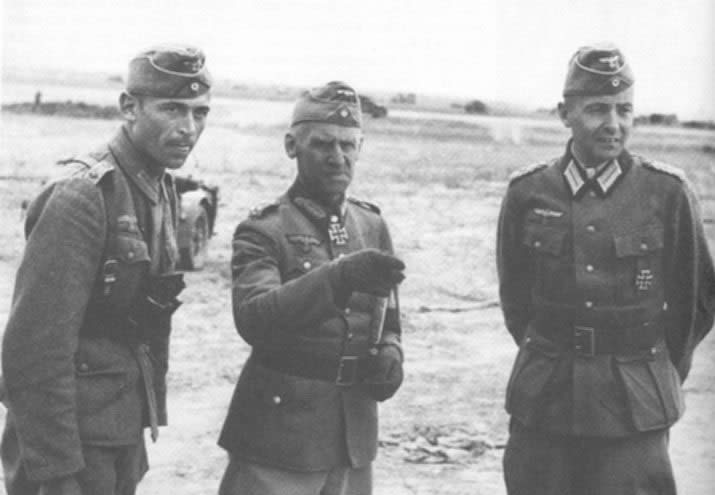Hermann Hoth (1885 - 1971)
Hermann Hoth was born April 12, 1885, the son of a medical officer. In 1904, Hoth took on officer’s training in the German army and was posted to the cavalry. In 1905 he switched to the infantry and was a Leutnant in the 72. Infanterieregiment. He served in this regiment during World War One as well. He served with distinction and was awarded both classes of the Eisernes Kreuz (Iron Cross).
After the war, Hoth – in the meantime risen to the rank of Kapitän – was taken into the Reichswehr. He recognized that mobile war fare was the way forward and to that end, he joined the staff of the department engaged in the secret development of motorized units. Initially he served under Oswald Lutz and later under Heinz Guderian. In 1922, Hoth was promoted to Major, in 1929 to Oberstleutnant and three years later to Oberst. In 1932, he was also placed in command of the 17. Infanterieregiment and subsequently in October 1934 he was ordered to establish the 18. Infanteriedivision.
After Hitler’s rise to power, conscription was re-introduced in Germany in October 1935. Hoth was also officially placed in command of the 18. Infanteriedivision. Exactly one year later, he was promoted to Generalmajor and he returned to the mobile branch of the German army. By the way, Erich von Manstein took over command from Hoth as divisional commander of the 18. Infanteriedivision. In November 1938, Hoth was promoted to General der Infanterie and thereupon occupied himself with training and equipping the four newly established light divisions. These were all incorporated in XV Korps and Hoth was officially placed in command of it.
With the war against Poland on the horizon, Hoth’s XV Korps was stripped to just two divisions (2 and 3 Leichte Division) and placed under command of 10th Army which was incorporated in Von Reichenau’s Heeresgruppe Mitte. World War Two officially began on September 1, 1939 and Hoth’s Korps participated in the encirclement of Polish forces at the river Bzura. In recognition of his services during the Polish campaign, Hoth was awarded the Ritterkreuz (Knight’s Cross) in October 1939.
The light divisions were not as successful during the Polish campaign as had been expected, whereupon they were converted to full strength armored divisions during the next winter. One of these was the 7. Panzerdivision (the former 2. Leichte Division) commanded by Rommel. In addition, Hoth’s XV Korps was reinforced with the 5. Panzerdivision and the 62. Infanteriedivision for the capture of France and the Low Countries in May 1940. During this campaign, Hoth’s XV Korps was one of the first units that managed to cross the river Meuse and subsequently create the inner flank of the armored spearhead that was tasked with the encirclement of the Allied main force by advancing towards the Channel coast. The Korps was surprised though and initially overwhelmed by the British counter attack near Arras on May 21st, 1940. After having repulsed this counter attack XV Korps participated in the dislodgment and destruction of the Allied forces at the Channel ports. In recognition of his services during the offensive in the west, Hoth was promoted to Generaloberst.
In November 1940, Hoth was placed in command of the newly established 3. Panzergruppe, part of Heeresgruppe Mitte commanded by Von Bock for the invasion of the Soviet Union. Operation Barbarossa was launched on June 22, 1941 and 3. Panzergruppe was involved in the massive encirclement near Minsk where over 300.000 Soviet soldiers were taken prisoner. Before the advance east could be resumed however, Hoth’ tanks had to wait for the infantry, still advancing mainly on foot. Hoth was ordered to wait as his superiors feared his flanks could be attacked. After Byelorussia was captured, Hoth was awarded the Eichenlaub (Oak Leaves) to his Ritterkreuz. Thereafter, Heeresgruppe Mitte struck towards Smolensk where his 3. Panzergruppe was involved in a massive encirclement once more. Again, hundreds of thousands of Soviets were taken prisoner and Hoth wanted to strike towards the hardly defended city of Moscow, along with Guderian’s 2. Panzergruppe. Hitler however had altered the operation plan once more and ordered Hoth to advance north in order to take Leningrad. The closer the Germans got to Leningrad however, the stronger the resistance became. Consequently, Leningrad was not captured and would never fall in German hands anyway.
Once again, Hitler had made an arbitrary alteration to the plans of operation: the tanks now were to advance to Moscow, Operation Typhoon. Shortly before the operation was launched however, Hoth was transferred to 17. Armee, succeeding Von Stülpnagel as its commander. 17. Armee was part of Heeresgruppe Süd and in the first winter at the Eastern front, it had to endure countless Soviet counter attacks, repulsing them all successfully, despite the loss of its main supply base at Lozovaya. Units of the 17th Army under command of Hoth, took part in the hunt for and murder of Jews. Towards the end of April 1942, Hoth took a short leave and command of 17. Armee was handed over to Von Salmuth.
Hoth was recalled however in order to lead the summer offensive in 1942: Fall Blau (Case Blue). Being commander of 4. Panzerarmee and in cooperation with 2. Armee he managed to take Voronjesh. Subsequently, 4. Panzerarmee joined 6. Armee commanded by Paulus and advanced along the southern bank of the river Don. Hoth’ 4. Panzerarmee however was transferred from 6. Armee’s left flank to its right flank in order to cut off the withdrawal of Soviet forces that had been driven out by the newly established Heeresgruppe Don. Hoth’ 4. Panzerarmee remained south of 6. Armee and advanced towards the city on the Volga bearing Stalin’s name: Stalingrad. 4. Panzerarmee supported the attack by 6. Armee but encountered fierce resistance from the Soviet 64th Army in mid August near Abanerovo. Despite defeating 64th Army, the Germans failed to encircle the Soviets in such large numbers anymore like in 1941 as the Soviets were now allowed to withdraw. Later on in Stalingrad, 6. Armee was engaged in one of the bloodiest battles of World War Two. Hoth’ tanks were tasked with the senseless mission to support 6. Armee in its street fighting, entailing horrendous losses. When the Soviets launched their counter offensive the next winter, 6. Armee and parts of 4. Panzerarmee were surrounded. Hoth himself was flown out of the pocket in order to command a relief action with the remnants of 4. Panzerarmee, now under command of Van Manstein’s Heeresgruppe Don.
Initially, the relief action, code named Wintergewitter was a great success. Heeresgruppe Don managed to get as close as 31 miles to Stalingrad when it was halted in its tracks by fierce Soviet resistance. Paulus had a chance to break out but Hitler did not permit him to do so, hence Wintergewitter became a massive failure, more so when the Soviets launched another counter attack, driving Hoth’ tanks back to the river Don. Miraculously, a new defensive line was set up near Rostov and thereafter, Hoth and 4. Panzerarmee participated in the recapture of Kharkov in March 1943. The Soviets were totally surprised by the German counter attack and as a result, Belgorod could also be taken by 4. Panzerarmee.
With the recapture of Kharkov and Belgorod, 4. Panzerarmee had created an advantageous starting position for the coming summer offensive. This offensive, aimed at squeezing out the huge Soviet salient near the city of Kursk, code named Zitadelle (Citadel) was launched on July 11th, 1943 and Hoth’ 4. Panzerarmee was deployed as the southern spearhead of the offensive. After some initial successes, the offensive bogged down in determined Soviet resistance and when the Allies invaded Sicily, it was cancelled alltogether. In subsequent Soviet counter attacks, 4. Panzerarmee was driven well back to the west, constantly attempting not to get surrounded. Contrary to Hitler’s orders, Hoth undertook a number of brilliant defensive actions, pulling back his 4. Panzerarmee and launching small counter attacks that inflicted heavy losses on the Soviets. In recognition of his successful achievements, Hoth was awarded the Schwerter (Swords) to his Ritterkreuz mit Eichenlaub in 1943.
In November 1943, the Red Army closed in on the Ukrainian city of Kiev. Hoth was afraid of getting surrounded and therefore had no other option than to ignore Hitler’s orders and evacuate the city on November 6th. Hoth simply had an insufficient number of tanks and troops at his disposal to defend the city. This led to his discharge and on November 15th, he was replaced by Erhard Raus. Hermann Hoth was relegated to the strategic reserve by Hitler but was recalled at the end of April 1945 in order to set up the defense of the Harz mountain range. He did very well in this until the end of the war.
At war’s end, Hoth was made a prisoner of war. In 1948, he was indicted by the court in Nuremberg, charged with war crimes and sentenced to 15 years imprisonment but was released in 1954. After his release Hoth wrote a number of books on military history.
Hermann Hoth passed away in 1971 in Goslar, Germany. He will be remembered as a brilliant tank general who managed to attain remarkable results with limited means in the campaigns against France and the Soviet Union.
Definitielijst
- cavalry
- Originally the designation for mounted troops. During World War 2 the term was used for armoured units. Main tasks are reconnaissance, attack and support of infantry.
- Eisernes Kreuz
- Iron Cross. German military decoration.
- Heeresgruppe
- The largest German ground formation and was directly subordinate to the OKH. Mainly consisting of a number of “Armeen” with few directly subordinate other units. A Heeresgruppe operated in a large area and could number several 100,000 men.
- infantry
- Foot soldiers of a given army.
- invasion
- Armed incursion.
- Iron Cross
- English translation of the German decoration Eisernes Kreuz.
- Jews
- Middle Eastern people with own religion that lived in Palestine. They distinguished themselves by their strong monotheism and the strict observance of the Law and tradition. During World War 2 the Jewish people were ruthlessly persecuted and annihilated by the German Nazis. . An estimated 6,000,000 Jews were exterminated.
- mid
- Military intelligence service.
- offensive
- Attack on a smaller or larger scale.
- Red Army
- Army of the Soviet Union.
- regiment
- Part of a division. A division divided into a number of regiments. In the army traditionally the name of the major organised unit of one type of weapon.
- Reichswehr
- German army during the Weimar republic.
- resistance
- Resistance against the enemy. Often also with armed resources.
- Soviet Union
- Soviet Russia, alternative name for the USSR.
- war crimes
- Crimes committed in wartime. Often concerning crimes committed by soldiers against civilians.
Images
Information
- Article by:
- Tom Notten
- Translated by:
- Arnold Palthe
- Published on:
- 19-01-2025
- Feedback?
- Send it!
Sources
- Panzer-Operationen, Hermann Hoth, 1956, Heidelberg, Samengesteld door Kurt Vowinckel
- De Duitse Generale Staf, Barry Leach, 1979, Standaard Uitgeverij Antwerpen, Oorspronkelijke Titel: German General Staff, Vertaald uit het Engels door: S.D. Nemo, ISBN: 0304358401
- Geschiedenis van de Tweede Wereldoorlog, compiled by Sir Basil Liddell Hart
- Axis Biographical Research













